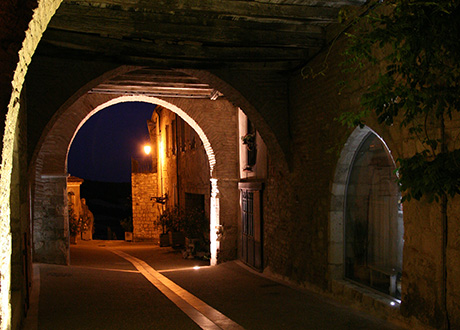« Reste ici, loin du bruit, du monde et des fièvres
Et bientôt, je le crois, tu me diras merci
Si tu fais un séjour en ce coin de Quercy ! … »
Invitations, Pierre Sourbié (1906-1985)

05 63 94 61 94
Discover

« Reste ici, loin du bruit, du monde et des fièvres
Et bientôt, je le crois, tu me diras merci
Si tu fais un séjour en ce coin de Quercy ! … »
Invitations, Pierre Sourbié (1906-1985)

Lauzerte has been classified since April 1990 among the villages labeled «The Most Beautiful Villages in France", villages selected for the quality of their heritage, their architecture and their environment. The acquisition of the label is the result of a rigorous selection. It is never definitive, therefore constant efforts are required to keep the title.
In Tarn et Garonne, three villages have this famous Label: Auvillar (also located on the path to Santiago de Compostela) and Bruniquel.
Chemin historique, légendaire, de spiritualité et de confluence socio-culturelle, la Via Podiensis, « Premier Itinéraire Culturel Européen », inscrite au Patrimoine Mondial de l'Humanité par l'UNESCO, est parcouru par le GR 65, sentier de grande randonnée.
Venant du Puy-en-Velay (Haute-Loire), il traverse le Tarn-et-Garonne sur 53 km.
Trois villes et villages, référencés comme « Halte sur le Chemin de St Jacques de Compostelle », ponctuent l'itinéraire où les pèlerins trouvent un point d'information et une structure d'accueil adaptés à leurs attentes : Lauzerte, Moissac et Auvillar.
Le GR 65 marque l'entrée du Chemin dans le département sur la commune de Sainte Juliette.
L'itinéraire offre sur toute sa traversée une grande variété d'entités paysagères qui ne dément pas l'image de « mosaïque de paysages » caractérisant le Tarn-et-Garonne.
www.chemins-compostelle.com
Le label "Communes Haltes - Chemins de Compostelle en France" s’adresse aux communes partageant des valeurs d’hospitalité et de solidarité, engagées dans une démarche forte visant à améliorer l’accueil des randonneurs, cheminants ou pèlerins.
Pour en savoir plus : https://www.chemins-compostelle.com/.../Labellisation...
In its origin, the hill of Lauzerte was a Gallic oppidum. Its current name comes from about the year 1000. Derived from the Latin "Lucerna", lamp, it designates an ideal position, visible from far away as a light.
At the end of the twelfth century, the Count of Toulouse received the hill in donation in order to build a Castelnau, a city protected by a castle. The Foundation was of strategic and economic interest, and an instant success. Two hundred building lots were distributed to settlers, attracted by the freedom granted. Lauzerte, around 1200, stretched along a single street, in the north, whereas a path was circumventing the plateau to the south. Between the two, the space was quickly occupied and the place created on the model of Montauban. The surrounded area was later urbanized.
Stop of the pilgrims to Santiago de Compostela, shopping precinct, populated and rich, as evidenced by its medieval houses, Lauzerte remains today one of the most beautiful and most outstanding high castelnau based in the Midi.
Placed in the heart of the Chasselas wine region and of the Quercy area of melon production, Lauzerte dominates an appetizing landscape where the paths wiggle between limestone plateaus and valleys. According to the change of seasons, the latter take the colors of fruit trees, sunflower, corn, wine, lavender,...
The richness of the small local heritage where dominates the brilliance of the limestone rock (pigeon houses, mills, isolated chapels, farms, plush,) echoed the charm of Lauzerte.
The high town, copy of the medieval architecture, organizes its houses around the church St-Barthélemy and the place of angles, one of the most beautiful in the region. The Ramparts evoke the role played by Lauzerte, torn between the English and the French during the Hundred Years War. The old houses, of gothic style or the Renaissance period, remind us that the City was also a paradise for the rich magistrates and prosperous merchants. The latter knew how to defend the privilege of their quality of life. Lauzerte continues today on this track, for the great pleasure of its visitors. "
The Regional Committee of tourism in Midi Pyrenees.
Of modest dimensions (35x30m), it extends where the enlarged summit of the cliff offers the best opportunities for development. Place of community life of the bastide by excellence: markets, announcement of consular decisions, place of spectacle and the place of execution. Lined with arcades in elliptical arcs on three of its sides and houses ranging from the XVth to the XVIIIth century., the place has a house on the corner which gives him the name.
It stretches, in an unusual way, perpendicular to the place. From the ancient building of the 13th century remain only the first span and the portal overlooking the place. The Church, during the various works of reconstruction and expansion, was reoriented. The different campaigns of building work can be distinguished. Interesting furniture: stalls, tables, baroque altarpiece painted paneling attributed to Joseph Ingres and his students, organ of choir.
After major periods of disorder, this military defensive structure that protected the door of Auriac from the assaults of the faubourg, has given place to an esplanade poetic. The magnificence of the place has also inspired a local poet:
"Of the ancient rampart which dominates the plain
where the long green ribbon of the Lendou deploys,
we can see every evening, amount of each roof,
small fumes that give them breath …"
La Barbacane, Pierre Sourbié (1906-1985)
This unique garden layout traces the history and initiatory journey of the Pilgrimage to Santiago de Compostela.
The garden is presented as a board game (like snakes and ladders). A path strewn with boxes and numbered panels allows players or walkers to move by following the steps which tell the daily life of the pilgrim.
Free entry throughout the year, leaflet and dice game available at the Tourist Office.
Lauzerte is far to be faithful to the plot in checkerboard typical for a bastide. The configuration of the site explains this adaptation. Two slender streets espouse the contours of the terrain and are interspersed with cross-sectional small streets. They are lined with merchant houses of white stone dating from the XIIIth and XIVth century, that testify a period of splendor in civil constructions in the bastide. They recall the era of prosperity where Lauzerte played the role of seed store of the city of Cahors. The unity of their facades is still readable under the transformations: on the ground floor, two openings in ogive (the Great reserved for the shop and the small to access the living area), a mezzanine lighted by fenestrous to store the goods, and the 1st floor vested to the housing, in fact the most noble part of the house, opening on two gemel windows with carved capitals and the attic with an oculus.
Named in reference to different assault of the city by this place (the English during the Hundred Years War and Protestants during the wars of religion).
Fontaine and ceramic pyramids created by Jacques Buchholtz in the garden below.
2th main artery in the bastide. It corresponds to 1 patchy of houses of the Castelnau, the most redrafted later on. Homes dating from the XVIIIth century with medieval vestiges (doors, windows …). Place of the powerful, opposed to the poor suburbs (popular neighborhoods and tanners).
It allows to appreciate the strategic position and defensive nature of Lauzerte, once stronghold guarding in the north the valley of the Barguelonne and the east the valley of the Lendou. This place marks the location of the former castle.
Created in the XVIIIth century on the ancient ditches, this layout responds to the desire of the Consuls (administrators of the bastide) to offer the inhabitants a place for promenade and cattle trade.
The external facades of the houses, anchored in the rock, served as rampart.
At the bottom of the city, at the exit of the suburb of Auriac. Created after the coming of the Carmelites in the VIVth century and their disappearance in the XVIIth century. As a result of the Wars of Religion and remodeled in the XIXth century Altarpiece Baroque organ, choir, Chair.
Lauzerte, so dear to Jacques Buchholtz, ceramist of art of international renown (disappeared too early in the eyes of all those who have known him), which inspired him, exposes everywhere his talent. Lovers of poetry, he loved this sentence of René Char: "A poet must leave traces of its passage, not evidence. Only the traces give birth to dreams". Its "traces", his works of ceramic can be admired in the medieval streets.
Invitations to dream...
Ceramic wall carpet , Office of Tourism, 51 carpets of enameled ceramics, Esplanade of the Barbican, uplifted corner , place of angles, ceramic village, interior court of the town hall, pyramids and fountain in enameled ceramics, garden of the breach, "inaccessible", totem of sandstone, scenic point space, plates of street names.
Original, unusual, it leaves nobody indifferent. Artistic creation conducted in late 1988 by the worldwide known ceramist Jacques Buchholtz, with blocks of ceramics, borders of limestone, reinforced concrete structure of 4 tons in instable equilibrium and industrial tiles.
"A square of light, in the middle of a bastide, a square of stones and earth assembled in a grid pattern of cobblestone.
A mineral square - raised in an angle as under a gust of wind showing underneath a shimmer of colors, to better illuminate the sight - raised in an angle as a climb to the sky. A call to other dreams, a springboard to the supernatural. An invitation to let you carry and just feel the emotion.."
Lauzerte has about 15 signs in wrought iron shaped by Sylvain Soligon, former ironsmith of art, which gives it a timeless charm: signs of pubs, the rooster and the cat (veterinary), statues representing a man and a compass (land surveyor), signs representing a scribe (Public Notary), a wind vane on the tourism office … . His son Didier and other iron workers of art, recently installed, perpetuate the tradition with new achievements.
the 3 Capucin - street of the barbican
A Capucin : monk belonging to the Capuchin Order
A Capucin : name given to the spoon, in the hand of the monk, who was used to collect the juice to baste meat.
A Capucin : another name for the hare represented under the chair.
Télécharger le dépliant de visite de Lauzerte download the leaflet

Discover all events click here
-

Office de Tourisme Intercommunal
du Pays de Serres en Quercy
10, Place des Cornières - 82110 LAUZERTE - Tél. 05 63 94 61 94